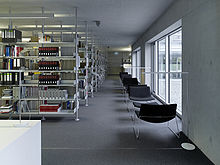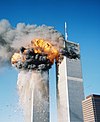
The Geheime Staatspolizei, abbreviated Gestapo, was the official secret police of Nazi Germany and in German-occupied Europe.
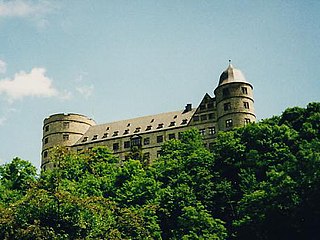
Wewelsburg is a Renaissance castle located in the village of Wewelsburg, which is a district of the town of Büren, Westphalia, in the Landkreis of Paderborn in the northeast of North Rhine-Westphalia, Germany. The castle has a triangular layout, with three round towers connected by massive walls. After 1934 it was used by the SS under Heinrich Himmler, and was to be expanded into a complex which would serve as the central SS cult-site.

The Reich Security Main Office was an organization under Heinrich Himmler in his dual capacity as Chef der Deutschen Polizei and Reichsführer-SS, the head of the Nazi Party's Schutzstaffel (SS). The organization's stated duty was to fight all "enemies of the Reich" inside and outside the borders of Nazi Germany.

The Memorial to the Murdered Jews of Europe, also known as the Holocaust Memorial, is a memorial in Berlin to the Jewish victims of the Holocaust, designed by architect Peter Eisenman and Buro Happold. It consists of a 19,000-square-metre (200,000 sq ft) site covered with 2,711 concrete slabs or "stelae", arranged in a grid pattern on a sloping field. The original plan was to place nearly 4,000 slabs, but after the recalculation, the number of slabs that could legally fit into the designated areas was 2,711. The stelae are 2.38 m long, 0.95 m wide and vary in height from 0.2 to 4.7 metres. They are organized in rows, 54 of them going north–south, and 87 heading east–west at right angles but set slightly askew. An attached underground "Place of Information" holds the names of approximately 3 million Jewish Holocaust victims, obtained from the Israeli museum Yad Vashem.

Edgar Julius Jung was a German lawyer born in Ludwigshafen in the Kingdom of Bavaria. He was a leader of the conservative revolutionary movement in Germany which stood not only in opposition to the Weimar Republic, whose parliamentarian system he considered decadent and foreign-imposed, but also opposed National Socialism. Jung was murdered in the 1934 Night of the Long Knives purge.

Peter Zumthor is a Swiss architect whose work is frequently described as uncompromising and minimalist. Though managing a relatively small firm, he is the winner of the 2009 Pritzker Prize and 2013 RIBA Royal Gold Medal.
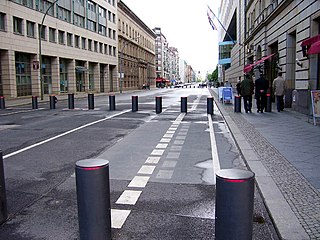
Wilhelmstrasse is a major thoroughfare in the central Mitte and Kreuzberg districts of Berlin, Germany. Until 1945, it was recognised as the centre of the government, first of the Kingdom of Prussia, later of the unified German Reich, housing in particular the Reich Chancellery and the Foreign Office. The street's name was thus also frequently used as a metonym for overall German governmental administration: much as the term "Whitehall" is often used to signify the British governmental administration as a whole. In English, "the Wilhelmstrasse" usually referred to the German Foreign Office.

The Nazi party rally grounds covered about 11 square kilometres in the southeast of Nuremberg, Germany. Six Nazi party rallies were held there between 1933 and 1938.
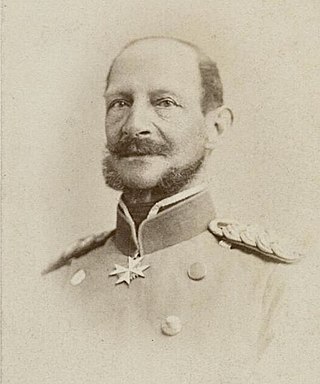
Prince Frederick Henry Albert of Prussia was the fifth son and youngest child of King Frederick William III of Prussia and Louise of Mecklenburg-Strelitz. His parents had fled to East Prussia after the occupation of Berlin by Napoleon, and Albert was born in Königsberg. Two of Albert's elder brothers were Frederick William IV, King of Prussia from 1840 till 1861, and William I, King of Prussia from 1861 to 1888 and German Emperor from 1871 until 1888.
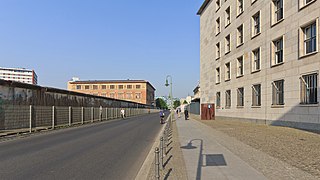
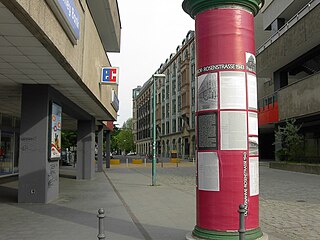
Fabrikaktion is the term for the last major roundup of Jews for deportation from Berlin, which began on 27 February 1943, and ended about a week later. Most of the remaining Jews were working at Berlin plants or for the Jewish welfare organization. The term Fabrikaktion was coined by survivors after World War II; the Gestapo had designated the plan Große Fabrik-Aktion. While the plan was not restricted to Berlin, it later became most notable for catalyzing the Rosenstrasse protest, the only mass public demonstration of German citizens which contested the Nazi government's deportation of the Jews.

Martin-Gropius-Bau, commonly known as Gropius Bau, is an important exhibition building in Berlin, Germany. Originally a museum of applied arts, the building has been a listed historical monument since 1966. It is located at 7 Niederkirchnerstraße in Berlin-Kreuzberg,

The neoclassical Brienner Straße in Munich is one of four royal avenues next to the Ludwigstraße, the Maximilianstraße and the Prinzregentenstraße. The boulevard was constructed from 1812 onwards, during the reigns of Maximilian I Joseph of Bavaria and his successor Ludwig I, in accordance with a plan by Karl von Fischer and Friedrich Ludwig von Sckell. The avenue is named after the Battle of Brienne.

Europahaus is a large high-rise office block in Berlin, Germany, located in the Kreuzberg district on Stresemannstraße, facing the remains of the former Anhalter Bahnhof railway terminus across Askanischer Platz. It was one of the first modern high-rise office buildings to be constructed in the city.

The Prinz-Albrecht-Palais was a Rococo city palace in the historic Friedrichstadt suburb of Berlin, Germany. It was located on Wilhelmstrasse 102 in the present-day Kreuzberg district, in the vicinity of Potsdamer Platz.

The Borsig Palace was an iconic building at the corner of Voßstraße and Wilhelmstraße in the center of Berlin and one of the grandest Italianate villas in Germany. Completed in 1877 for industrialist Albert Borsig, who died before he could move in, the building served for a time as a bank. In 1933 it became the residence of Vice-Chancellor Franz von Papen, where dramatic scenes relating to the Night of the Long Knives would play out just one year later. In the aftermath, Palais Borsig was converted into the new headquarters of the Sturmabteilung on Adolf Hitler's direct orders. It was then integrated into the New Reich Chancellery by Albert Speer in 1938. The palace was severely damaged in World War II and, together with Hitler's Chancellery, demolished by the Soviet forces in 1947.

The Gedenkstätte Berliner Mauer commemorates the division of Berlin by the Berlin Wall and the deaths that occurred there. The monument was created in 1998 by the Federal Republic of Germany and the Federal State of Berlin. It is located on Bernauer Straße at the corner of Ackerstraße and includes a Chapel of Reconciliation, the Berlin Wall Documentation Centre, a 60-metre (200 ft) section of the former border, a window of remembrance and a visitor center.

Gustav Adolf Nosske was a German lawyer and SS-Obersturmbannführer. In 1941–42, he commanded Einsatzkommando 12 within Einsatzgruppe D, under the command of Otto Ohlendorf. Tried in the Einsatzgruppen Trial in 1948, Nosske was sentenced to life imprisonment. He was released early in December 1951.

The Reich Ministry of Transport was a cabinet-level agency of the German government from 1919 until 1945, operating during the Weimar Republic and Nazi Germany. Formed from the Prussian Ministry of Public Works after the end of World War I, the RVM was in charge of regulating German railways, roadways, waterways, and the construction industry - a kind of infrastructure agency in today's understanding. In the 1920s, the Ministry's involvement in the rail sector was limited to administrative and technical supervisory functions. The National Railway was initially organized as an independent state-owned company to guarantee that Germany paid war reparations according to the provisions of the 1924 Dawes Plan.
The Nazi Forced Labour Documentation Centre is located in the Berlin district of Niederschöneweide in the Treptow-Köpenick district. It documents the fate of the forced labourers during the National Socialist era and is the only one of its kind in Germany.









